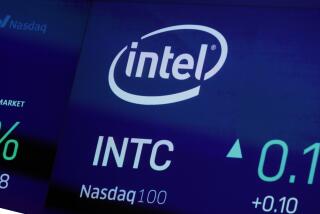Intel Chief Andrew Grove Steps Down
- Share via
SAN FRANCISCO — Andrew S. Grove, who left Hungary as a penniless refugee in the 1950s and went on to become one of the most admired and powerful business executives in the world, said Thursday that he is stepping down as chief executive of Intel Corp., a company he built into a driving force of the computer age.
The news signaled not only the end of an era at Intel, but the close of a glorious chapter in Silicon Valley’s history. Grove, 61, was the most prominent active member of a dwindling class of pioneers who came to the valley in the 1960s and established it as the technology capital of the world.
Grove’s sudden but not entirely unexpected announcement was softened only by the fact that he will remain chairman of Intel and continue to work full time in the same sparsely decorated cubicle he has occupied for years.
“I have thoroughly enjoyed being Intel’s CEO for the past 11 years,” Grove said, “and now I would like to focus more of my time on broad strategic issues concerning the industry and Intel.”
Grove will relinquish the chief executive title in May to Craig R. Barrett, the president of the company who has been groomed for this succession and is already responsible for much of Intel’s day-to-day management.
The transition comes as Grove seemed to be reaching the peak of his career. His Santa Clara-based company is among the most profitable in the world, his management books are bestsellers and his opinions set the course for the entire PC industry. Just three months ago, Grove was named Time magazine’s Man of the Year.
But it is also a precarious time for Intel. Its chips are found in about 85% of the world’s personal computers. But Intel has been slow to align itself with new trends, such as the surging popularity of low-priced PCs and the proliferation of other computing devices--including television set-top boxes and hand-held computers--that increasingly use other companies’ chips.
“Grove clearly presided over a very prosperous time at Intel,” said Linley Gwennap, editor of the Microprocessor Report in Sunnyvale. “But there are certainly signs emerging that life is going to be more difficult in the future for Intel than it has been.”
In an interview Thursday, Grove, who battled prostate cancer several years ago, said his health is fine and was not a factor in his decision to resign.
“I’ve been president for almost 20 years,” he said, “so I’m ready for a little bit more flexibility in my work agenda.”
Grove, whose personal worth is estimated at more than $300 million, presented his resignation to Intel’s board of directors Wednesday. The news was delivered to Intel’s 64,000 employees via a brief electronic memo. True to Intel’s no-frills culture, there were no speeches or dramatic gestures.
Employees took the news in stride, largely because the transition--if not the precise timing--had been anticipated since Grove turned over the title of president to Barrett last year.
The announcement didn’t shake Wall Street’s confidence in the company either. Intel shares rose $2.13 to close at $78.19 on Nasdaq. That also reflected Intel’s announcement that it will buy back 100 million shares, or about 6% of the total outstanding.
Grove said he has gotten a few calls from well-wishers, including one at 7 a.m. from Steve Jobs, the interim chief executive of Apple Computer, a company that has never used Intel chips. But Grove showed no signs of nostalgia.
“I heard [the resignation] being reported on the radio today while I was shaving,” he said. “I commented to my wife that it didn’t give me any funny feelings. That’s kind of how I’m made up. I rarely look back.”
The transition marks the first time in Intel history that the top position won’t be held by someone who was present at the founding of the company in 1968.
At that time, Grove stood in the shadows of legends Robert Noyce and Gordon Moore, who defected from struggling Fairchild Semiconductor to found Intel. For many years, Grove was responsible for the company’s sprawling manufacturing operations. Gradually, he became more involved in the company’s strategy, and over the past few decades has guided Intel through crises and triumphs.
In the mid-1980s, Intel was decimated by Japanese competition in the market for computer memory chips. Grove was largely responsible for the risky decision to abandon the memory market and bet the company’s future on microprocessors, the brains of a computer.
Intel has been cashing in ever since. The company got a huge head start when its chip was selected for IBM’s first PC, and has built an empire by predicating its business on Moore’s famous prediction that microprocessors would double in power every 18 months.
As part of the so-called Wintel duopoly with Windows maker Microsoft, Intel acquired such a stranglehold on the microprocessor market that by the early 1990s the only way for it to grow was for the entire PC industry to expand.
Driving that expansion has been Grove’s obsession through most of this decade. Intel has spent billions of dollars building brand awareness, researching such new uses for PCs as teleconferencing, and helping to fund dozens of start-up software companies.
Intelligent, charismatic and proudly paranoid, Grove created an atmosphere at Intel that is fiercely competitive. Early on, he was known for glaring out his window at employees who dared to arrive late for work, and would browbeat managers who disappointed him.
That trademark aggressiveness may also explain Intel’s strained relationship with rivals and regulators. Competitors have long complained that Intel elbows them out of the market, prompting two investigations by the Federal Trade Commission, including one that is ongoing. No action has been taken against the company so far.
Grove has also made some tactical blunders, most notably his initial decision not to offer replacement chips to consumers when a flaw was discovered in the Pentium processor in 1994 that caused calculation errors. Stunned by the outcry, he reversed himself and offered replacements.
Overall, Intel’s performance under Grove has been remarkable. Intel’s stock price has risen more than 750% in the past five years. In 1997, the company reported a profit of $6.9 billion on sales of $25.1 billion, both numbers roughly triple what they were in 1993.
But there are troubles looming. Intel’s fat profit margins have depended on demand for powerful microprocessors that cost up to $700 apiece. But that’s a shrinking breed now that sub-$1,000 PCs are the hottest segment of the market.
Grove’s mantra--”make the PC it”--has also left the company unprepared for the emerging markets for other electronic devices that also need microprocessors. Recently, Intel was dealt a setback when cable television giant Tele-Communications said it would use another company’s chips in its new set-top boxes. Those devices and other new consumer appliances are expected to drive much of the growth in the technology industry in the coming years.
These are areas Grove plans to give attention in his new role.
“It wasn’t this complicated 10 years ago,” Grove said.
He stresses that the company will be Barrett’s to run come May, and that he will only serve as an advisor. Analysts expect him to continue to play an important role.
But it does mark a major milestone in the improbable life of a Silicon Valley icon.
Grove was born Andras Grof in 1936 in Budapest, the son of a Jewish dairy worker and bookkeeper. He survived scarlet fever at age 4, the Nazi occupation in the 1940s and the Soviet invasion in the ‘50s.
He fled by train to Austria, then made his way to America. Grove excelled at City College of New York and UC Berkeley, where he earned a doctorate in engineering. His first job was alongside Noyce and Moore at Fairchild.
Sometimes, Grove said, he considers the remarkable course of his life.
“There are times when I scratch my head and marvel at it.”
* CHALLENGES FOR CEO: Craig Barrett must respond to the low-priced PC trend and take Intel into new markets. D1






